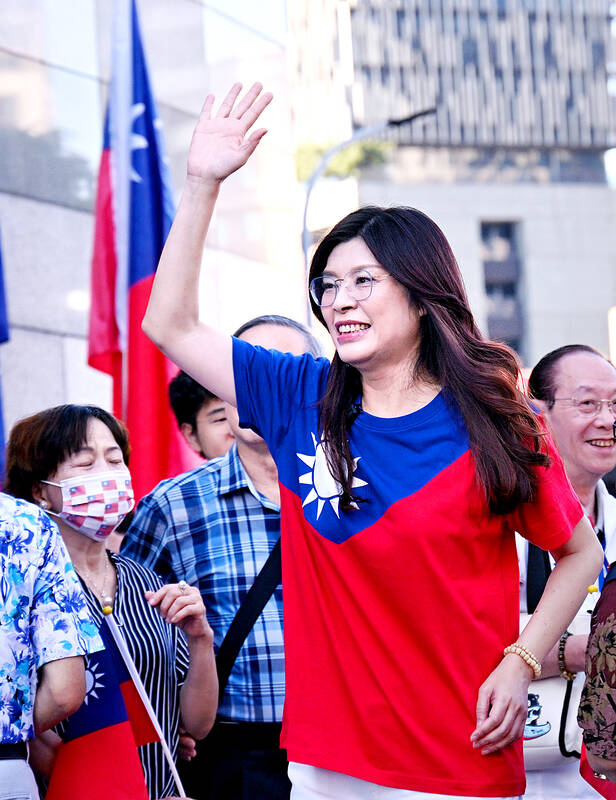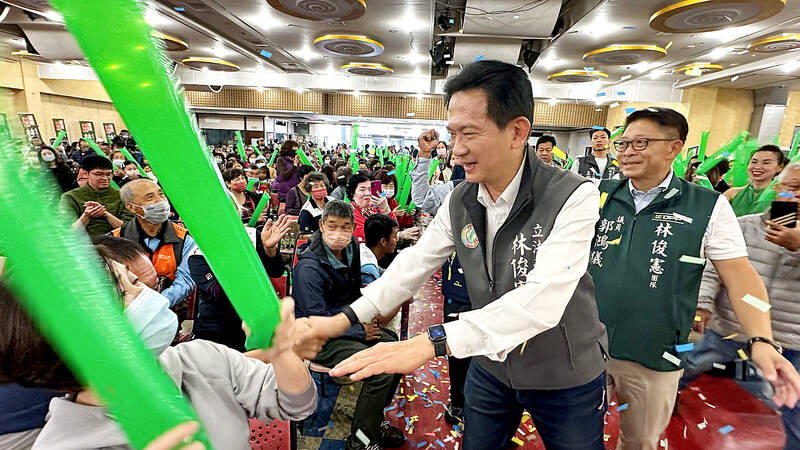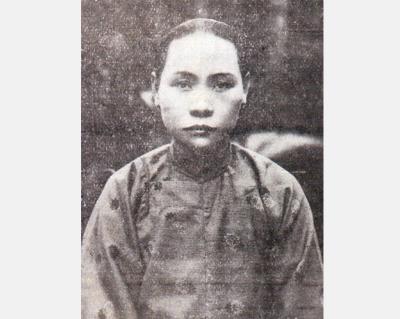Even the most casual followers of Taiwan politics are familiar with the terms pan-blue and pan-green. The terms are used so casually and commonly with the assumption that everyone knows what they mean, that few stop to really question it.
The way these terms are used today is far broader and extensive than what they were originally created to represent. Are these still useful shorthand terms, or have people become so obsessed with them that they color perceptions to the point of distortion?
LEE TUNG-HUI WAS NO SMURF

Photo: Fang Pin-chao, Taipei Times
People often assume that these terms have been around forever, or at least as long as Taiwan has had democratic elections. They are treated as an immutable, permanent, and intrinsic to Taiwan’s politics, as if they were a force of nature.
In the 1996 presidential election, was Chinese Nationalist Party (KMT) candidate Lee Tung-hui (李登輝) pan-blue, or was he secretly pan-green all along? At the time, the question would have made no sense, and asking that question would have earned puzzled looks.
Yet, today it is not uncommon to see writers — especially younger ones — framing the politics of the era in these terms.

Photo: Liu Wan-chun, Taipei Times
At the time, the question would have been whether he was a secret supporter of Taiwan independence and sympathetic to the fledgling Democratic Progressive Party (DPP), or whether he was the anti-communist, pro-unification Chinese nationalist stalwart that he and his party presented him as.
Amazingly, in polling at the time, both sides assumed he was one of theirs, a rare feat in the history of politics. He won in a landslide, and to the shock of many in the KMT, he was a lot less one of theirs than they had anticipated.
No one called him “green” at the time; he was not a noted environmentalist or a member of the Green Party. No one called him “blue” because he was not a Smurf.
CRUCIBLE OF TUMULTUOUS TIMES
The turn of the century was a tumultuous time in Taiwan politics. The KMT split in the 2000 election, handing victory to the DPP’s Chen Shui-bian (陳水扁) after a bitterly fought race.
The KMT’s rising star at the time, James Soong (宋楚瑜), felt spurned after Lee passed him over to get the uninspiring and uncharismatic Lien Chan (連戰) nominated to represent the party. Soong ran as an independent and lost to Chen by less than 2.5 percent of the vote, leaving Lien in the dust as a distant third.
Post-election but prior to Chen’s inauguration, two big political changes occurred. KMT politician Su Chi (蘇起), a former Secretary-General of the National Security Council, pushed for the adoption of the term “1992 consensus.” The term had been used prior to this in a more vague sense, but he popularized the term and helped form the KMT’s current definition of what it means.
The other was Soong formed the People First Party (PFP), which attracted widespread support and was for a time more popular than the KMT. Soong’s popularity, charisma, and new vision caused significant defections from the KMT, swelling the PFP’s ranks.
As far as I can determine, the phrase “green terror” to attack the new Chen administration as being as bad or worse than the KMT’s 1950s “white terror” began to appear by at least late 2000, and appears to be the first instance of using this color in this political sense to distinguish it from “white.” The phrase remains popular today among KMT and TPP supporters.
Ahead of the December 2001 legislative elections, another splinter group broke away from the KMT and formed the Taiwan Solidarity Union (TSU, recently renamed Taiwan Solidarity Party). Though he never joined the party, the TSU named Lee Tung-hui as their “spiritual advisor” and campaigned on a stronger Taiwan independence stance than the DPP.
In that election, the KMT lost their legislative majority for the first time. Taking office in February 2002, the new legislature lacked a single dominant party.
Of the 225 seats, the DPP caucus was the biggest with 87 seats, the KMT was second with 68, the PFP third with 46, the newly formed TSU had 13, the fast-fading New Party (NP) had one seat and independents picked up nine seats.
In an already bitter and tense political environment, the legislature formed into two broad ideological coalitions of Chinese and Taiwanese nationalists. To stymy the Chen administration’s efforts, the KMT, PFP, and NP together held a one-seat 113 majority, bolstered by independents. Similarly, to support the administration the DPP and TSU also voted as a bloc.
As these two warring camps went at it in the legislature, a shorthand was needed in place of “KMT-PFP-NP coalition” and “DPP-TSU coalition.” Politics often uses martial analogies, so my best guess is they picked the colors of the two coalition leaders’ banners spearheading the charge on each side, taking “blue” from the primary color on the KMT flag and “green” from the most prominent color on the DPP’s flag.
Regardless of the exact origin, it stuck.
WHERE BLUE/GREEN GETS MURKY
The original narrow shorthand for legislative coalitions began to expand to apply to the parties themselves and their ideological camps. Green represented support for Taiwanese identity, nationalism, and sovereignty, while blue represented Chinese versions of the same.
These new expansions of the terms remained useful, but they did obscure considerable ideological variation between the parties, and even between different camps within the parties.
Eventually, this was extended to individual politicians, with “light” and “deep” used to add a crude nuance. The terms are used to denote how far on the spectrum ideologically they are, with “light” being closer to a mainstream position and “deep” closer to the ideological core of what “green” and “blue” are supposed to represent.
For example, former KMT Chairman Johnny Chiang (江啟臣) is considered light blue, while current Chairwoman Cheng Li-wun (鄭麗文) is usually labelled deep blue. However, many KMT politicians do not neatly fall into either category.
Today, there is only one green party of any significance, the DPP. The term is only useful in contrast to blue.
Even “light” and “deep” are not very useful when it comes to DPP politicians today. The party has become so homogenous ideologically in the last decade it is hard to definitively identify any major politician as broadly either.
The usefulness of the terms grows even blurrier when applied to individual voters and some districts. For example, Hakka and indigenous voters often lean blue, but this does not necessarily mean they are particularly blue ideologically. There are historical reasons they distrust the DPP.
The reasons for voting one way or another can be for a wide range of reasons having little to do with ideological affiliation. Family, social, and historical ties can play big roles.
Voters also “lean” one way or the other by type of election. In local elections, the KMT has won the last two in landslides. Here in Taichung, Mayor Lu Shiow-yen (盧秀燕) is very popular with voters, but not because — or in spite of — any ideology, but rather because she is widely perceived as being good at running the city.
What about the Taiwan People’s Party (TPP)? In the original sense of the term, based on how their legislative caucus votes, they are unambiguously in the pan-blue camp. The party has sided with the KMT in the recent referendum, in the recalls, and is in negotiations on forming a unified front in next year’s local elections.
It is when examining TPP (and NPP) supporters’ responses to polling on issues that typically define pan-blue and pan-green ideology that the messiness of using the blue/green framework becomes apparent. Stay tuned for that deep dive.
Ultimately, people pick shorthand terminology for convenience. That these terms are still widely in use suggests people still find them useful.
The risk is that they color people’s perceptions to the point of blindness and obscure more than they illuminate.
Donovan’s Deep Dives is a regular column by Courtney Donovan Smith (石東文) who writes in-depth analysis on everything about Taiwan’s political scene and geopolitics. Donovan is also the central Taiwan correspondent at ICRT FM100 Radio News, co-publisher of Compass Magazine, co-founder Taiwan Report (report.tw) and former chair of the Taichung American Chamber of Commerce. Follow him on X: @donovan_smith.

The Lee (李) family migrated to Taiwan in trickles many decades ago. Born in Myanmar, they are ethnically Chinese and their first language is Yunnanese, from China’s Yunnan Province. Today, they run a cozy little restaurant in Taipei’s student stomping ground, near National Taiwan University (NTU), serving up a daily pre-selected menu that pays homage to their blended Yunnan-Burmese heritage, where lemongrass and curry leaves sit beside century egg and pickled woodear mushrooms. Wu Yun (巫雲) is more akin to a family home that has set up tables and chairs and welcomed strangers to cozy up and share a meal

Dec. 8 to Dec. 14 Chang-Lee Te-ho (張李德和) had her father’s words etched into stone as her personal motto: “Even as a woman, you should master at least one art.” She went on to excel in seven — classical poetry, lyrical poetry, calligraphy, painting, music, chess and embroidery — and was also a respected educator, charity organizer and provincial assemblywoman. Among her many monikers was “Poetry Mother” (詩媽). While her father Lee Chao-yuan’s (李昭元) phrasing reflected the social norms of the 1890s, it was relatively progressive for the time. He personally taught Chang-Lee the Chinese classics until she entered public

Last week writer Wei Lingling (魏玲靈) unloaded a remarkably conventional pro-China column in the Wall Street Journal (“From Bush’s Rebuke to Trump’s Whisper: Navigating a Geopolitical Flashpoint,” Dec 2, 2025). Wei alleged that in a phone call, US President Donald Trump advised Japanese Prime Minister Sanae Takaichi not to provoke the People’s Republic of China (PRC) over Taiwan. Wei’s claim was categorically denied by Japanese government sources. Trump’s call to Takaichi, Wei said, was just like the moment in 2003 when former US president George Bush stood next to former Chinese premier Wen Jia-bao (溫家寶) and criticized former president Chen

President William Lai (賴清德) has proposed a NT$1.25 trillion (US$40 billion) special eight-year budget that intends to bolster Taiwan’s national defense, with a “T-Dome” plan to create “an unassailable Taiwan, safeguarded by innovation and technology” as its centerpiece. This is an interesting test for the Chinese Nationalist Party (KMT), and how they handle it will likely provide some answers as to where the party currently stands. Naturally, the Lai administration and his Democratic Progressive Party (DPP) are for it, as are the Americans. The Chinese Communist Party (CCP) is not. The interests and agendas of those three are clear, but